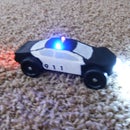Introduction: The Fishtank Blender. "The Blender Tank"
Is the blending power of your blender not as good as it used to be? Has your blender stopped working altogether? Did you get three blenders as wedding gifts? Then your in luck. Hear is a very eye catching fish tank that will get your house guests talking.
Step 1: Will My Blender Work As a Fish Tank?
There are some considerations that make a blender a good candidate for making a fish tank. First you need to make sure there is a good viewing area with the glass so you can see the fish. The more water that can fit inside, the better for the fish. If you do not have a blender and want to buy one for this project make sure you consider these factors.
Step 2: List of Meterials.
Little is needed to make a tank. If you don't want to install a pump (and you don't have to) then nothing is needed at all. Just get some fake plants and drop them and a fish in. If you want your tank to be more high tech and have bubbles coming from the bottom to stir the water to help with the O2 levels then you will need to install a pump. Hear is the items you need.
The smallest pump you can find.
Clear tubing
A bubble rock
A one way valve
The pump is stored in the bottom of the blender where the motor is located. The one way valve is so water does not go back down into the pump and cause a short.
Step 3: Install the Pump
Now that you have the parts and the blender you need to open up the bottom part of the blender where the motor is stored. The lid should be on the bottom of the blender. There should only be a few screws to get out. Once you have it open you need to see how the pump will fit. For me I did not have to remove anything inside. The pump was small enough to fit in between the wall and the motor. If your pump does not fit, then you might need to remove some items inside the blender or modify the pump to get it to fit. The one way valve also will be housed in this area so make sure there is enough room for it too.
Step 4: Install the Clear Hose.
Now that you have a spot to put the pump you need to feed the clear hose up to the tank. You need to drill two holes. One hole in the upper part of the blender and another in the same place in the lower part of the blender. I used me Dremel with a drill bit to do this. This will feed the air from the pump down at the bottom to the tank. Feed the hose through the hole. Connect the hose to a one way valve that will also be stored in the motor cavity. Then connect the one way valve to the pump with another hose.
Step 5: Make the Hose Water Tight.
I encountered a problem with making the hose connection not leak water. Hear is a very simple way to solve this.
To make the connection water tight, take the bubble rock and connect it to the end of the hose inside the tank. Then feed the hose back into the hole. Once you feed the hose enough so the end of the bubble rock starts to enter the hole that you made, it will create a seal. Push it down so it makes a tight seal. No glue is needed so that there is no chance to contaminate the water.
Step 6: Does It Work?
Once you have this done you can see if the system works. Plug in the pump and fill the tank with water. If some bubbles start to rise up then it works. Since it is a very small tank you should try to regulate the amount of air that is going through the system. On my pump there was a way to decrease the power to lessen the air flow. If your pump does not have a regulator then you can bury the bubble rock in rocks or kink the hose to lessen the air flow.
Step 7: To the Finish
If everything works then put it all together. Put the pump and valve in the motor cavity. You can remove the power cord for the blender and put the power cord for the pump in the same place. Put the cover back on. Then put the tank on top of the unit as it should go. That's it! your done. Now have fun. You can fill the tank with rocks and plants and of course fish. I had a snail in mine for a long time and it worked well.
You might want to put some ventalation holes in the lid. For my blender the lid has two parts. The black rubber outer part and a clear plastic part that can be removed. I drilled holes in the clear part but mostly I just have the clear part removed.
Runner Up in the
Joby Transform It! Challenge
Finalist in the
What Can You Do with a Dremel Tool?
Participated in the
Epilog Challenge













